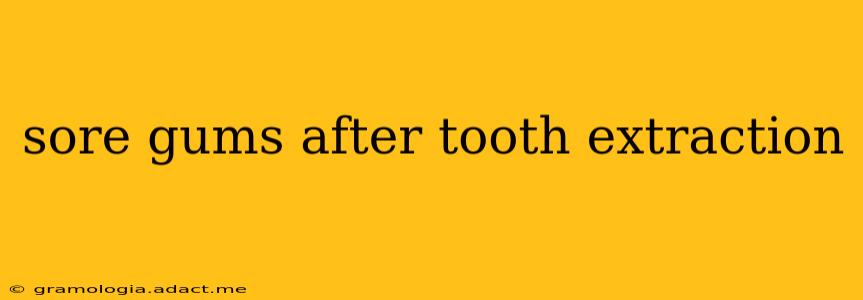Having a tooth extracted can be a necessary procedure, but it often leaves you with sore gums afterward. This discomfort is completely normal, a natural part of the healing process. However, understanding what to expect and how to manage the pain can significantly improve your recovery. This comprehensive guide will address common concerns and provide helpful advice on dealing with sore gums after a tooth extraction.
What Causes Sore Gums After Tooth Extraction?
The soreness you experience stems from the trauma inflicted on the gum tissue during the extraction process. The surgical removal of the tooth inevitably causes some damage to the surrounding gum tissue, leading to inflammation and pain. The body's natural healing response involves inflammation, which is characterized by swelling, redness, and pain. Moreover, the extraction site is a wound, and like any wound, it requires time to heal and will be sensitive. The presence of blood clots also plays a role; while essential for healing, the clot itself can put pressure on the nerve endings, causing discomfort.
How Long Does Soreness Last After a Tooth Extraction?
The duration of soreness varies significantly depending on factors like the complexity of the extraction, individual healing rates, and adherence to post-operative instructions. Generally, the most intense pain subsides within the first 24 to 72 hours. However, some degree of tenderness may persist for several days, even up to a week or two. If pain persists beyond two weeks or worsens, it's crucial to contact your dentist or oral surgeon.
What Can I Do to Relieve Sore Gums After a Tooth Extraction?
Managing post-extraction pain effectively is key for a smooth recovery. Here are several strategies:
- Over-the-counter pain relievers: Ibuprofen or acetaminophen can help manage pain and inflammation. Always follow the recommended dosage instructions.
- Ice packs: Applying ice packs to the affected area for 15-20 minutes at a time, several times a day, can reduce swelling and numb the pain.
- Saltwater rinses: Gently rinsing your mouth with warm saltwater (1/2 teaspoon of salt dissolved in 8 ounces of warm water) several times a day helps cleanse the extraction site and promote healing. Avoid vigorous rinsing, as this can dislodge the blood clot.
- Rest: Give your body ample time to rest and recover. Avoid strenuous activities.
- Soft foods: Stick to a soft food diet for the first few days to avoid putting pressure or irritation on the extraction site.
Is it Normal to Have Swelling After a Tooth Extraction?
Yes, swelling is a common and expected occurrence after a tooth extraction. The degree of swelling varies, but some puffiness is normal. Ice packs are your best ally in reducing swelling. If the swelling is excessive or spreads beyond the extraction site, it's important to consult your dentist.
When Should I Call My Dentist After a Tooth Extraction?
Contact your dentist or oral surgeon immediately if you experience:
- Severe, persistent pain that doesn't respond to over-the-counter pain relievers.
- Excessive bleeding that doesn't stop after applying pressure.
- Signs of infection, such as increased swelling, redness, pus, or fever.
- Difficulty opening your mouth.
- Numbness that persists longer than expected.
How Can I Prevent Dry Socket After a Tooth Extraction?
Dry socket, or alveolar osteitis, is a painful complication that can occur when the blood clot at the extraction site is dislodged. To prevent dry socket, follow your dentist's post-operative instructions carefully. This includes avoiding smoking, using a straw, and spitting vigorously, all of which can dislodge the clot.
What Foods Should I Eat After a Tooth Extraction?
Focus on a soft food diet for the first few days after extraction. Good options include:
- Yogurt
- Applesauce
- Mashed potatoes
- Scrambled eggs
- Oatmeal
- Soups
By following these guidelines and maintaining close communication with your dentist, you can effectively manage sore gums after a tooth extraction and ensure a smooth and speedy recovery. Remember, patience and proper care are crucial for optimal healing.
